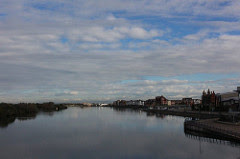 |
| Sketch map of Southport |
Southport's easy enough to get to by train (so long as the services are behaving themselves!) and there's some good birdwatching within very easy reach of the railway station. There are also good bus services from Liverpool and Preston to the town centre. I don't claim to be a local expert — I try to get over there about once a month — these notes describe some of the routes I've explored and found useful.
This walk is the purple line on the map. If you have the time and energy the full 4½ mile walk through to Crossens can be very productive, though it can be a bit of a slog if the weather turns nasty. (If the weather does turn nasty you'll at least have the usual wind behind your back.) Otherwise you can just take a walk round the marine lake; turn off at Hesketh Road and get a bus back from Hesketh Park; or turn off at Marshside Road and get the bus back from the stop opposite the school.
Turn right as you come out of the station, walk to the end of the pedestrianised area and turn left onto London Road. Walk straight down the road to the Promenade at the end. Cross the Promenade and walk down over the bridge. This is a good stopping point to check out the Marine Lake. You could easily spend a long while walking round the lake: in Winter it's good for ducks and gulls, in Summer check out the little egrets nesting on the island — it's surely only a matter of time till cattle egrets join them.
Continuing on from the lake, past the retail park, cross Marine Drive at the Guelder Rose pub and have a look around from the sea wall. When the tide's out it can look like the salt marsh goes on forever. Looking out you'll usually see shelduck, redshanks, linnets and the occasional little egret. The shared footpath/cycle path takes you the couple of miles or so to Crossens. As you walk north away from the pier the marsh gets thicker. In Winter there's usually a few small groups of pink-footed geese and be careful to take a good look at the flocks of linnets that are kicking around as a good few of them will actually be twite. It's more of the same as you continue walking, with skylarks and meadow pipits, sometimes a stonechat or two, joining in as the ground gets slightly higher and drier. For all that Marine Drive is a busy road and the path is well-used there's a lot of bird life close to hand.
Turn right as you come out of the station, walk to the end of the pedestrianised area and turn left onto London Road. Walk straight down the road to the Promenade at the end. Cross the Promenade and walk down over the bridge. This is a good stopping point to check out the Marine Lake. You could easily spend a long while walking round the lake: in Winter it's good for ducks and gulls, in Summer check out the little egrets nesting on the island — it's surely only a matter of time till cattle egrets join them.
 |
| Southport Marine Lake |
The junction with Hesketh Road is the beginning of the RSPB's Marshside reserve. Crossing the road here (carefully! it's a very busy — and fast — road) there's a seat giving you a good, though slightly distant, view of this corner of the reserve. About a hundred yards up the road there's a platform giving a closer view of the pool and right across this half of the reserve. In Winter there are large numbers of black-tailed godwits and wigeon, it tends to be quieter in Summer but it's always worth checking out (I saw my first glossy ibis from here).
Walking back and re-crossing Marine Drive carry on walking north. This seems to be the point where the salt marsh to your left changes character: the Winter flocks of geese and skylarks get bigger and your chances of seeing a bird of prey get better, usually a kestrel though I've seen peregrines and hobbies flying low over this area.
 |
| Pink-footed geese |
Looking ahead you'll be able to see a rough mound on the horizon. This is the sand works opposite the main hide. As you approach the halfway mark between Hesketh Road and the sandworks keep an eye on the opposite side of the road for Nels Hide. It's slightly back from the road, mostly hidden by bushes; you're as likely to notice the path to it as the hide itself.
Nels Hide overlooks a shallow pool with a few islands. In Winter there are large numbers of ducks — pintail, wigeon, teal and tufted ducks — and waders, mostly black-tailed godwits and lapwings with a few ruffs and redshanks. There are usually little egrets to be found and surprisingly often you may see one or more of the cattle egrets that have taken a liking to the Sefton coast. In Summer the water retreats and — if it isn't a scorcher like 2018 — this part of the reserve attracts passage waders. Sedge and reed warblers nest near to the hide and swallows have been known to nest inside the hide.
 |
| Little egrets and cattle egret |
 |
| Glossy ibises |
Marshside Road cuts the reserve in two. In the next post I'll explain how to get to this point by bus and I'll describe the rest of the reserve. In the post after that I'll complete the journey to Crossens.

No comments:
Post a Comment